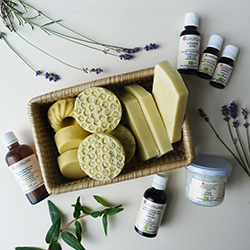Making your own natural soaps
Summary
Summary
Cold saponification is an ancient method of making all-natural soaps with three basic ingredients: water, vegetable oils and caustic soda. This method preserves the quality of the vegetable oils and retains all the glycerine from the saponification process, for nourishing and moisturising soaps. An ecological, economical, easy and pleasant method that also limits packaging in the bathroom. To get started, follow the guide!
Cold saponification Soap is the product of saponification: a chemical reaction that occurs when an oily substance (vegetable oil, vegetable butter, wax) is mixed with a solution of soda or potash dissolved in water, called a "base". Under the effect of the heat generated by the chemical reaction and the mixing, the fatty acids and the base combine to form soap and glycerine. Cold saponification is an ancestral method that makes it easy to produce soap at home or in a traditional way, using simple, local ingredients if possible and in an economical way.
To make your own natural soaps, you will have to handle caustic soda, which requires that you follow safety instructions. Highly corrosive, lye can cause serious burns if it comes into contact with the skin.
To make your soaps safely, follow these rules:
The first time you embark on the adventure of creating your own soaps, you will have to invest in a little bit of equipment, but you will see that the investment will quickly pay for itself as you use it!
To create your soaps you will need:
But also: clays, fresh plant and/or fruit juices, vegetable powders, dried flowers, honey etc...

The instructions below follow all the steps in making cold process soap, refer to the recipes at the bottom of the file for the ingredients.
Make sure you work on a clean and clear work surface, with all the materials you need to make your soap out, and prepare your soap mould(s) before you start.
This method is similar to the first one, the only difference is the water, with a trick to make the soda+water solution cool down faster and the two mixtures reach the same temperature faster.
Then follow the same steps as for method 1.





